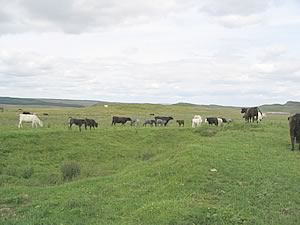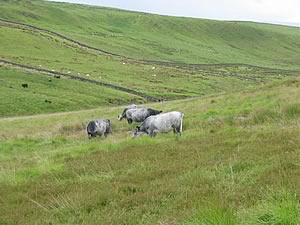 |
|||||||||
|
||||||||||||||||||||
| news index | Northumberland National Park Drovers Project The Drovers Project is a two year project managed by Northumberland
National Park Authority with partnership funding from the
Heritage Lottery Fund, the Countryside Agency, English
Nature and the National Trust. Started in 2003 the project
has now been running for just over a year, and is set to
draw to a close in May 2005. The Drovers Project is a two year project managed by Northumberland
National Park Authority with partnership funding from the
Heritage Lottery Fund, the Countryside Agency, English
Nature and the National Trust. Started in 2003 the project
has now been running for just over a year, and is set to
draw to a close in May 2005.
However, in recent years, traditional cattle breeds have been largely overshadowed by continental breeds such as the Charolais, Simmental and Limousin. A traditional breeds survey undertaken as part of the Drovers project revealed the extent of the decline in numbers of our native cattle breeds. Continental cattle, with their leaner appearance and faster maturing attributes were felt to be better suited to the changing beef production systems and markets. Although popular with many farmers from a commercial viewpoint, these breeds are less able to maintain the nature conservation value of key habitats found within the National Park, such as upland mires and areas of heather regeneration. As such, traditional breeds have developed a vital new role in helping to maintain the biodiversity of the uplands through grazing sites for conservation objectives, such as those within the Drovers Project. At the forefront of such work are the Galloway and its cross the Blue Grey, widely regarded as being unrivalled as conservation grazing animals, and increasingly being recognised for their ability to graze rough grassland habitats in particular. The broader grazing preferences of breeds such as the Blue Grey reduce the cover of rank grasses such as Purple Moor Grass and open up the sward to encourage greater species diversity.
The first site to be
grazed under a Drovers project agreement was Cragend
on Hotbank Farm, in the Hadrians Wall area of the National
Park. This site has now been grazed for two seasons,
for a period of 10 weeks each. The objective for this
site has been to use Galloway and Blue Grey cattle to
reduce the dominance of Purple Moor Grass (Molinia caerulea)
in order to open up the vegetation sward to allow greater
species diversity and to encourage heather regeneration.
|
|||||||||||||||||||

|
|
|||||||||||||||||||
| home | agri-services | pedigree
pen | news | dairy | beef | machinery | property | organisations | site map |
||||||||||||||||||||
Northumberland National Park Authority

